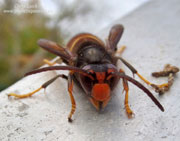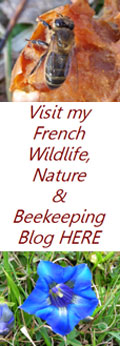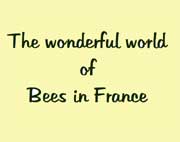Wildlife in France
Promote your Page too
Asian Hornet - Vespa velutina nigrithorax - Frelon asiatique
First observed in 2005 the Asian Hornet is thought to have arrived in France from China in 2004, in a container of pottery passing through the port of Bordeaux. Since that date its spread throughout the neighboring regions has been rapid and often, in the initial stages, follows rivers and other watercourses. In fact it will never be found far from a source of water even if that is only a small pond. As of 2011 there are reports of them being observed in Belgium and they are to be found in strong pockets in the north of France, the expansion is relentless.
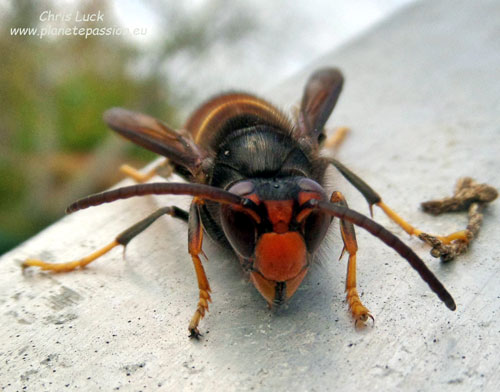
Slightly smaller than the European Hornet, with queens up to 30mm, and workers up to 25mm, they are easily recognised by their appearance and difficult to confuse with any other species. The thorax is a velvety black / dark brown with brown abdominal segments. Each abdominal segment has a narrow posterior yellow border, except for the fourth segment, which is orange. The legs are brown with yellow ends and the head is black with an orange yellow face.
Below top -Comparison Asian Hornet & European Hornet
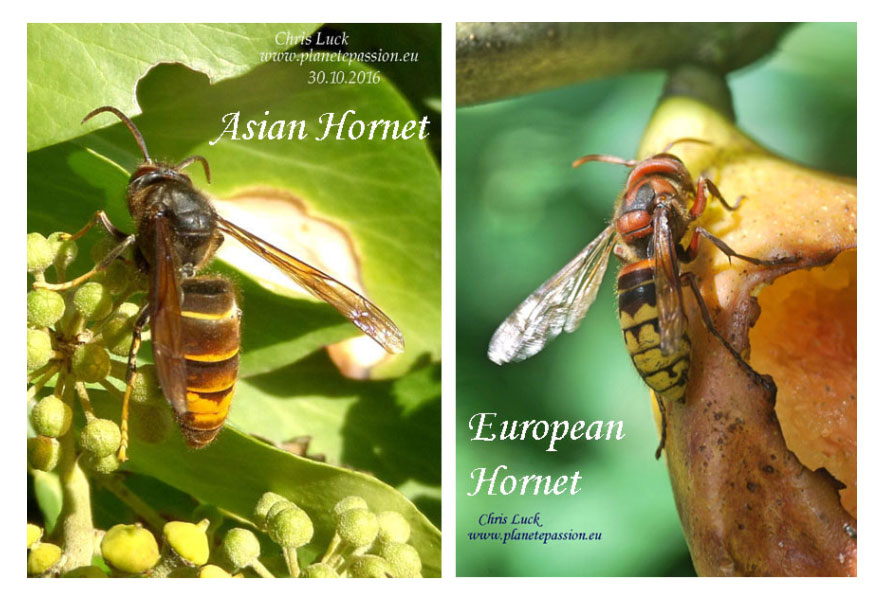
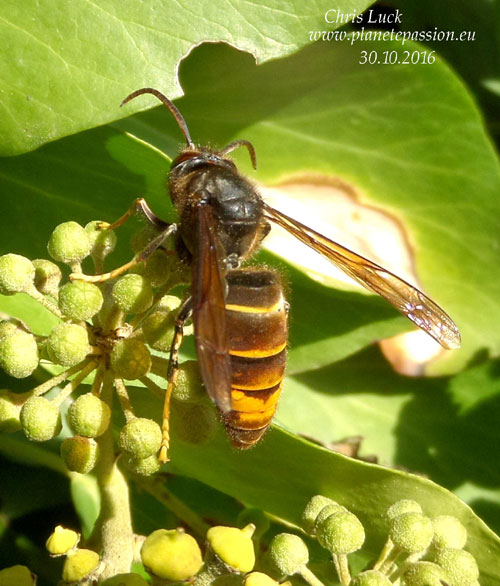
Above: Asian Hornet Queen on Ivy 30th October 2016
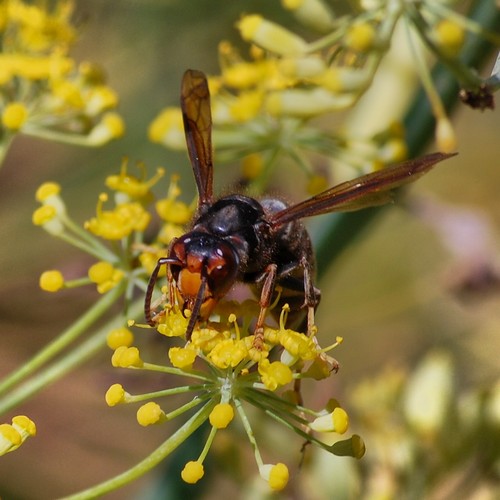
Asian Hornet - France
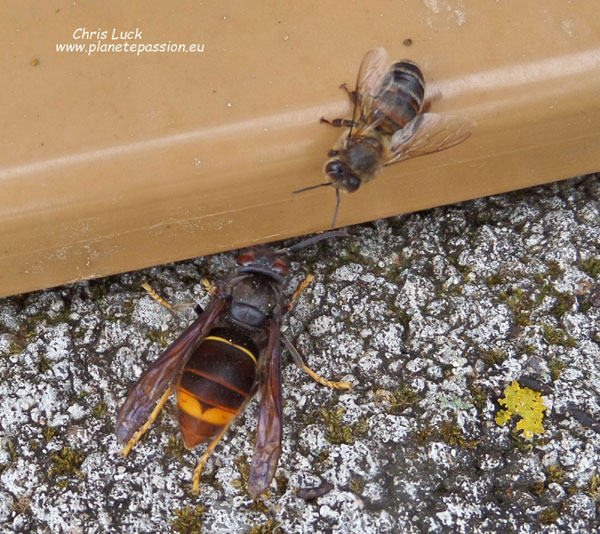
Photo Above - Asian Hornet Queen attracted by honey in early April following hibernation.
The nest is built using “paper mâché” made from chewed tree and plant material. It is composed of several wafers of cells surrounded by a double skinned envelope of broad reinforced paper scales, striated with beige and brown. Unlike the European Hornet where the entrance is on or near the bottom, the entrances are on the sides, (see photo). Another difference is that the European hornet makes its nest in cavities, whereas the Asian Hornet makes a suspended nest, usually in a tree but sometimes in a large open roof space. This is easy to see; it is spherical or oval and can be as much as 1 metre in height, 80cm in diameter and generally between 4 and 15 metres from the ground. It is rare for it to use a hollow in a tree or cavity although it can happen. Unfortunately the nest is sometimes hidden by the trees foliage and as its comings and goings are more discrete than the European hornet their presence isn’t always noticed until the leaves begin to fall in early autumn.
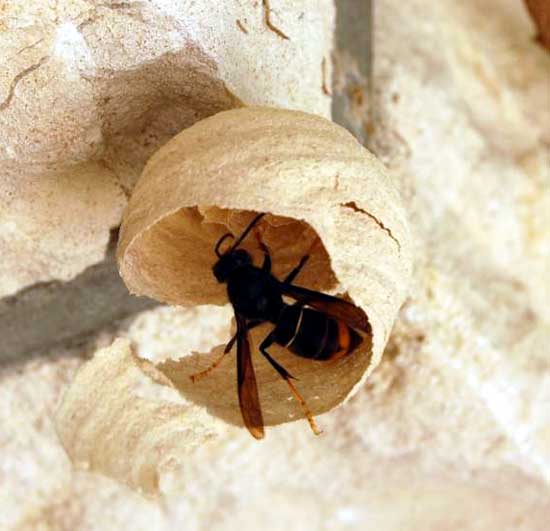
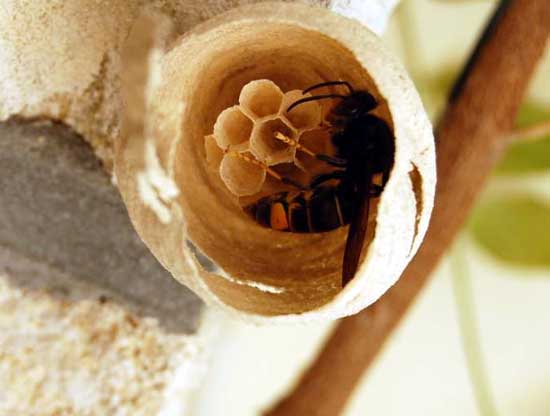
Photos above: Queen Asian Hornet constructing her initial nest. Below on the outside surface.
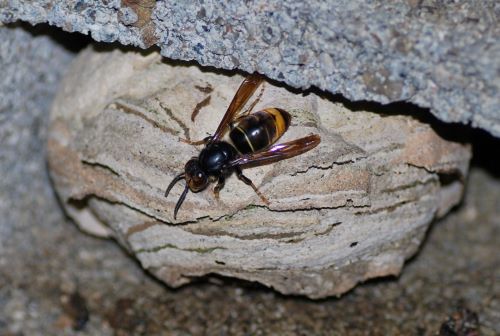
Although the European Hornet will attack and kill the odd honey bee in small numbers as a food source for their larvae it does not present a problem, however the situation is far worse with the Asian Hornet and can possibly lead to the destruction of the entire colony. The Asian Hornets will station themselves hovering at about 30cm from the entrance to the honey bee colony where they pounce on returning bees, often those that are carrying pollen, fall to the ground with them or fly a short distance to land on something and cut off the head with their mandibles. Here they remove the wings and legs before making a little “meat ball” that they transport back to their nest to feed their own larvae. Having found a colony, often a bee hive, they will sometimes arrive in numbers to take an easy food source one after another. The consequences for the bee colony could be catastrophic if the flow of pollen into the hive is severely disrupted. Over time it could result in the death of some or all of the larvae and the queen could either stop or reduce her egg production. This will lead to the decline of the colony, aging bees will die with few or no replacements to take their place. At best the colony will be vulnerable to disease due to the dead larvae and the overall weakness of the colony could lead to robbing. The colony will have a much reduced hope of over wintering. However there is increasing evidence that they are taking other insects as a source of protein to feed their larvae and even behaving more like the European Hornets and native wasps in taking meat including carrion.
Photo immediately below of Asian Hornets on a dead Blackbird and beneath that on a dead mouse.
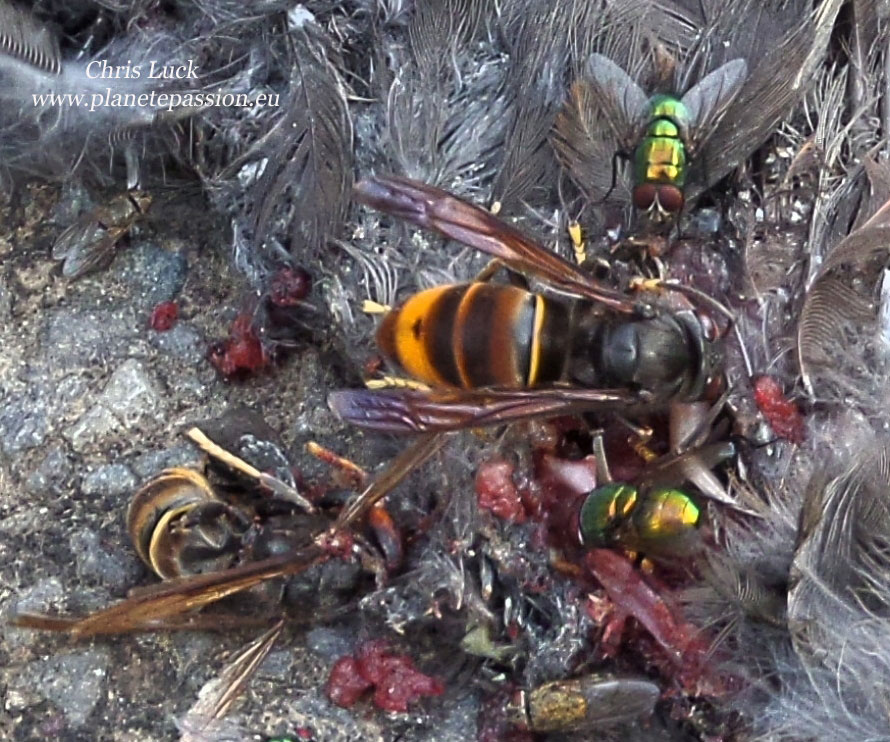
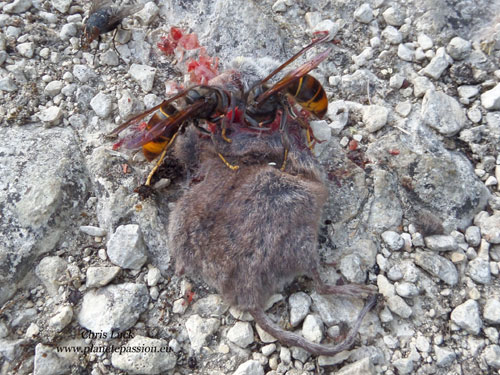
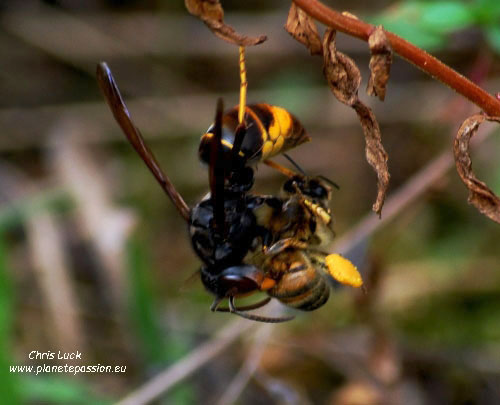
Above: Asian Hornet killing a honey bee
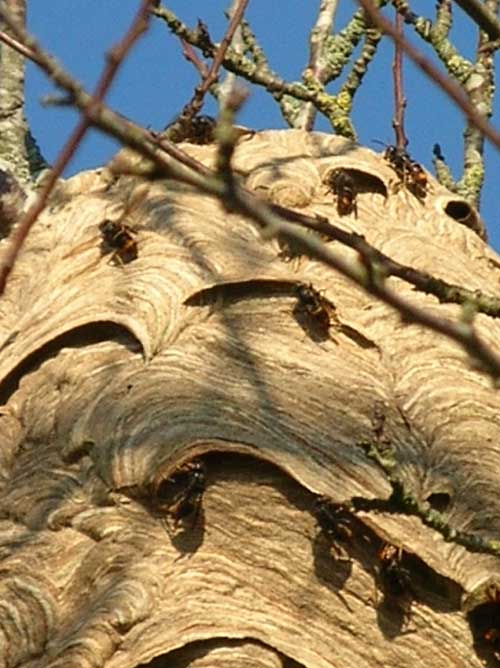
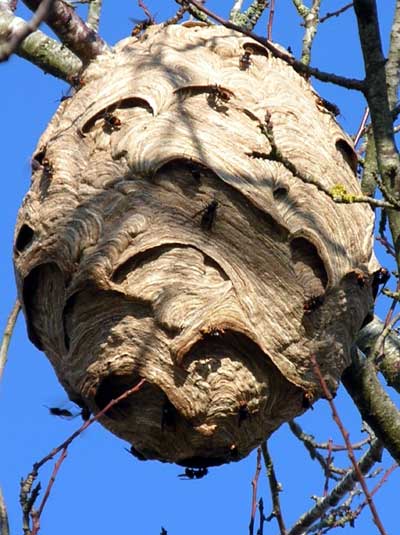
Photos above: Asian hornets nest suspended in a tree showing the entrance slits.

Photo above shows Asian Hornets and Honey bees feeding together on wax and honey in late October. At this time the Asian hornets will not kill the bees because they have stopped producing eggs and there are no larvae to feed, although they will rob weak bee colonies of their honey stores if given the opportunity although Hornet protection grills can be fitted to hives if required or the hive entrance reduced by other means.
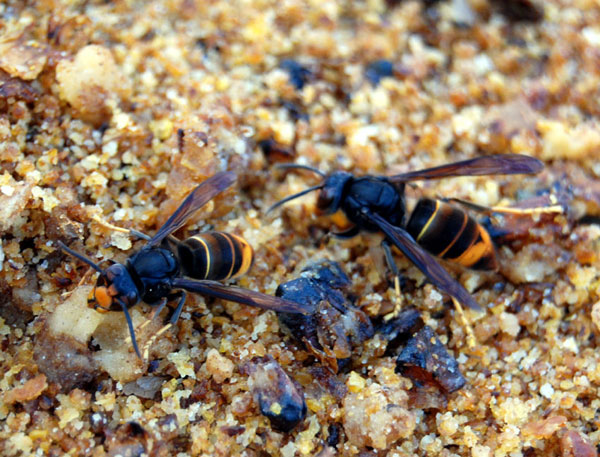
Photo above: Asian Hornets feeding on honey and wax.
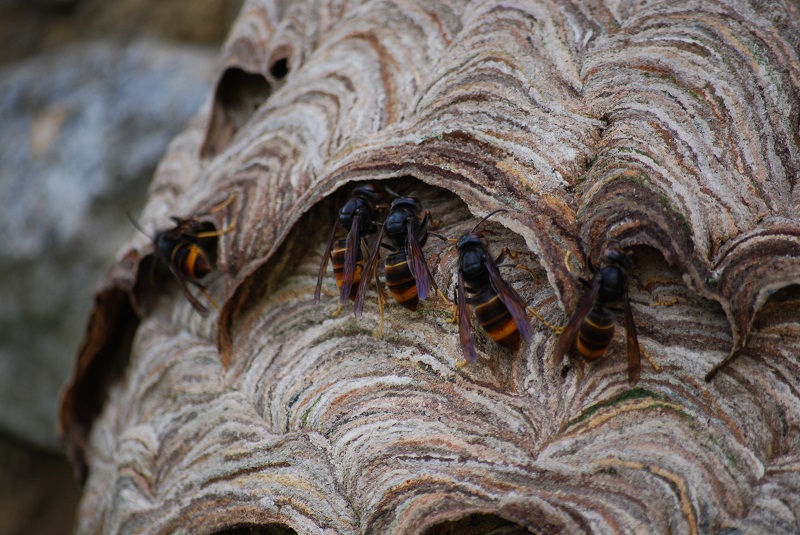
Photo: Asian Hornets nest inside a stone wall in France.
See. http://wild-life-in-france.blogspot.fr/2013/10/asian-hornet-nest-in-stone-barn-wall.html
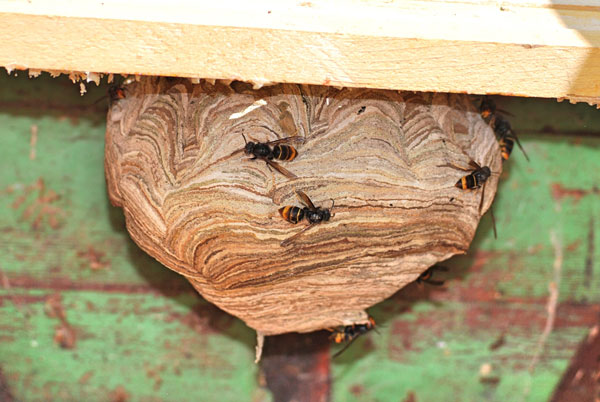
Photo. Asian Hornets nest in an empty bee hive, Vienne, France
See ASIAN HORNETS NEST IN AN EMPTY HIVE
Scale of risks for honey bees:
It's increasingly unclear just what the scale of threat is to Honey bees and it's possibly been overstated. There is no question about the fact that they do prey on bees at the colony entrance but it's likely that there would need to be a very large Asian Hornet colony in very close proximity to a bee colony to cause serious harm especially if there were a number of bee colonies together spreading the load. It could be that the risk is greater in the south of France with a longer season for the Hornet colony to get started and grow in size.
Photo below is an Asian Horents nest in my apiary 2014, not visible until the leaves fell in November.
See. ASIAN HORNET NEST IN MY APIARY
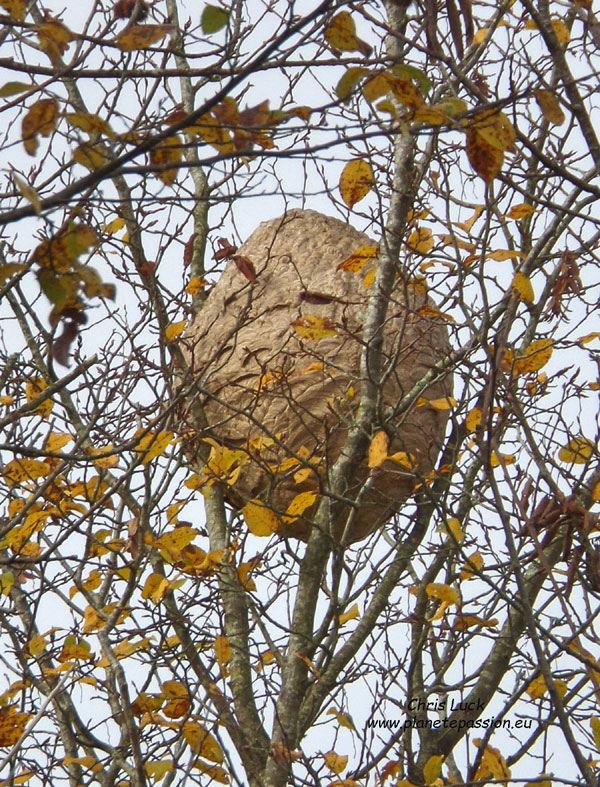
Risk to humans from this species is minimal except when and if they consider their nest to be under threat, otherwise they are more timid than the European Hornet and their sting is no worse than that from an ordinary wasp.
They are only out during daylight hours unlike the European Hornet that will also fly at night.
As with all the social wasps (common Wasps, Hornets and Polistes), the colonies of the Asian Hornet live only one year and it is only fertilised queens survive the winter in hibernation.
Solutions:
Small nests with only a queen at the beginning of the season, (as in the photos at the top), can be destroyed using a powerful aerosol wasp spray with caution.
Larger nests should be destroyed as a matter of urgency by a competent person that is equipped for the job. As the destruction of their nests and the laws surrounding it is a constantly changing situation you should check with your Mairie but the current situation is that there is a legal obligation on the property owner to have nests destroyed.
In early spring try to kill as many Queens as possible. They will be easily lured to the scent of honey and I find swatting them with a plastic tennis racket is the easiest method.
Please don't use traps as they will also attract and kill our native species of Hornet and Social Wasps which are already suffering enough and in decline.
